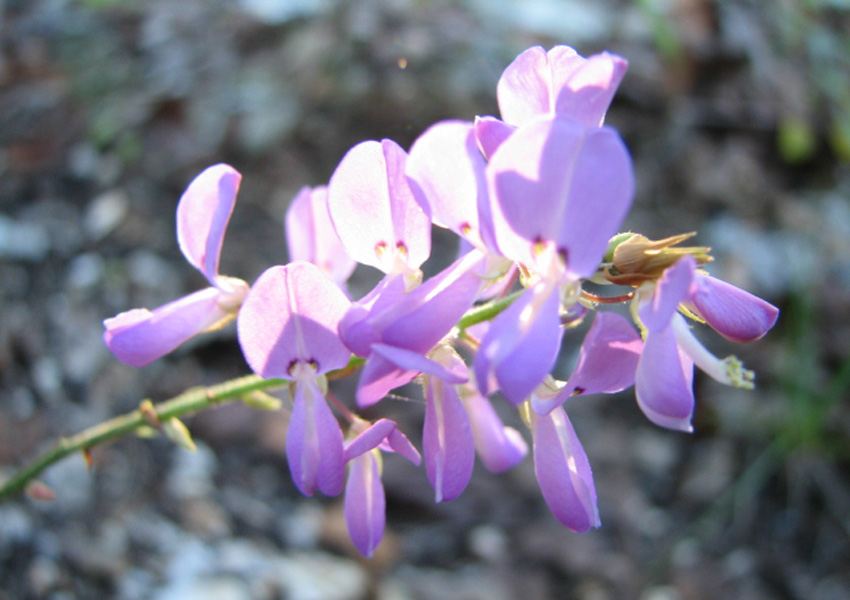


My dissertation research focused on the perennial legume, Desmodium cuspidatum (large-bracted tick-trefoil, Fabaceae). This species has experienced a dramatic decline in the northeastern portion of its range in the last 30 years, from approximately 28 populations in the mid-1970s to just nine populations as of 2007. However, populations elsewhere in the species range have not declined. This project synthesizes of many aspects of the biology of Desmodium cuspidatum in an attempt to identify causes of its decline in New England. Analyses of genetic diversity, reproductive biology, demography and responses to increases in N deposition draw on comparisons between New England populations and those located elsewhere in the species range.
Desmodium cuspidatum (Muhl. Ex Willd.) DC. Ex D. Loud. is found throughout the eastern half of the United States (Gleason and Cronquist, 1991), however, New England populations have declined by 75% in the last 30-40 years. Although never considered abundant, D. cuspidatum was once regarded as occasional in dry rocky woodlands in New England. Now it is listed as endangered in both Vermont (Program, 2005) and Connecticut (Murray, pers. comm.) and as threatened in Massachusetts (Massachusetts Natural Heritage and Endangered Species Program, 2008). It is listed as historic in New Hampshire and Rhode Island where extant populations are no longer know. Because populations outside of New England seem to be secure, the species has a global status of G5, or demonstrably widespread, abundant and secure (NatureServe 2008). Nonetheless, it is now listed among 110 other plant species considered rare in New England and in need of conservation and research (Brumbeck and Mehrhoff, 1997). Because resources are often limited, conservation efforts that impact a suite of species are most favorable.
Habitat loss, change, and conversion are typically invoked to explain population loss in plant species that have declined. Such causes do not appear to explain the dramatic loss of entire populations of D. cuspidatum from New England. Habitat changes appear to have been minimal in places where it once occurred. Many historic populations occurred on property that has been protected for decades and in some situations, a century or more (Harper, 2002). Similarly, fire, major windstorms, and other natural events seem unlikely to have caused population losses. Studies of pollen records and historical reconstructions of individual forests in New England show that large-scale events, like intense fires and catastrophic windstorms, were uncommon in presettlement central New England. As few as eight fires may have occurred at the Harvard Forest (Petersham, Massachusetts) in the last 7800 years (Foster, 1992). Foster (1992) also states that while Native Americans inhabited many areas in New England, their impacts on the regional scale was minor. There is no evidence to suggest that large-scale landscape disturbance have been more common in the last thirty years than they were before.
Demographic data also provide vital information for identifying vulnerable life history stages. Such data collected on New England populations from 2003 - 2007 suggest that population growth is limited by low reproductive success (fruit set) and recruitment (low germination rates). Extant populations appear relatively secure and exhibit no decline over the duration of this study. Nonetheless, deer browse reduces already low reproductive success even further. As a result, it may reduce the viability of populations where it has a large impact. Patterns of genetic diversity in New England populations are similar to those range-wide, suggesting that the loss of New England populations was to the result of short-term events that led to rapid local extinction, rather than within-population processes causing a slow decline over a long period of time.
Because belowground processes can be essential to the survival of individuals and populations understanding how N deposition affects the long-term persistence of populations of this N2-fixing species is an essential component of this project. Increasing N deposition may increase the vulnerability of particular life history stages and may change the competitive abilities of individuals. Experimental evidence indicates that non-N2-fixing species (e.g. Solidago) can acquire fertilizer N (simulated N deposition) better than D. cuspidatum and also use N2 fixed by D. cuspidatum. As a result, D. cuspidatum plants produce more nodules than when grown with out the non-N2-fixer, and continue to fix N2 at high levels of fertilizer N.
The synthetic nature of this project makes it possible to speculate about hypotheses that may explain population loss and low reproductive success of D. cuspidatum. Enhanced aboveground biomass of Solidago may reduce aboveground biomass of Desmodium cuspidatum through competition not only for fixed and available N, but also for water, other soil nutrients, light, and pollinators. Such competition could lead to smaller D. cuspidatum plants with fewer flowers and could also lead to depressed reproductive success (fruit set) when pollinators preferentially visit the flowers of Solidago. Field data show that there is a significant relationship between plant size (stems, leaves, inflorescences, stem height) and flower production in D. cuspidatum. Greatly enhanced aboveground biomass in S. canadensis at high N deposition rates may lead to enhanced flowering and associated distraction of pollinators from D. cuspidatum. Field observations suggest that pollinators preferentially visit S. canadensis flowers over those of D. cuspidatum when they co-occur and are both in flower. Solidago flowers provide both pollen and nectar rewards, whereas those of Desmodium cuspidatum provide only a pollen reward.
Studies of demography and reproductive biology revealed that extremely low reproductive success and recruitment (birth) rates might be limiting population growth. Furthermore, patterns of genetic diversity suggest that current populations harbor high levels of genetic diversity but might be threatened in the future if gene flow is restricted among existing populations.


email: kskogen@chicagobotanic.org phone: (847) 835-6919
the Chicago Botanic Garden, 1000 Lake Cook Road, Glencoe, IL 60022.
all content © Krissa Skogen 2010
the Chicago Botanic Garden, 1000 Lake Cook Road, Glencoe, IL 60022.
all content © Krissa Skogen 2010










